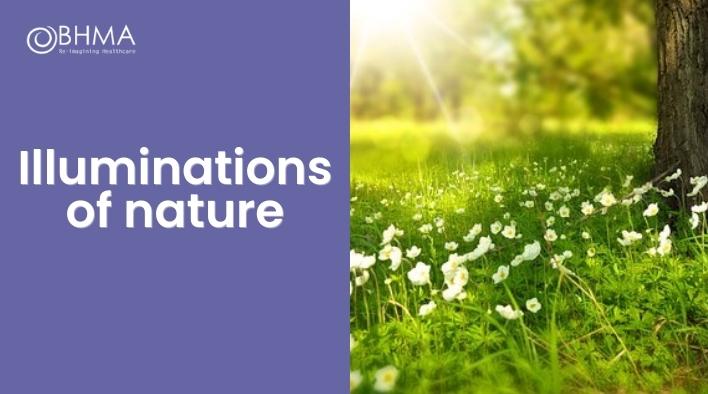Illuminations of nature
Fiona Hamilton, Poet
Published in JHH16.1 – Nature Connections
I am a poet with a fascination for oral traditions as well as words on the page. Giving voice to our lives, choices and perplexities, and allowing for quiet, can enhance our personal ecosystems and, by extension, environments around us. I devise and deliver projects with this aim: recently with Page Park Wellbeing Project, Penny Brohn UK, Freedom from Torture and Knowle West Healthy Living Centre. The poems in Fractures (2016, Gomer Press) concern farmland and medieval buildings the Brecon Beacons. I continued my exploration of the earth and human interactions with it in a piece on clay and brick in Cornerstones (2018, Little Toller Press) and for BBC Radio 3. I describe writing about nature and themes of habitations in the journal Axon: Creative Explorations (2019)
What can ‘nature poetry’ offer in the face of climate crisis? What can a fossil-fuel-dependent human in a post-industrial society say about hills, trees, insects, verdant slopes and babbling streams? In 2019, how can poetry avoid sentimental pseudo[1]romanticism or mere rant? How can a poem truthfully and wholeheartedly speak of a fragmented world afflicted with pollution, confronting the depletion of many species? Poems can soothe, uplift, remind us of beauty – but can they speak of healthy relationships between humans and our environment?
I recently wrote some poems on the site of a medieval farm in Wales called Llwyn Celyn. It sits at the gateway to one of the narrow eastern valleys of the Black Mountains. The writing was part of a project responding to the changing state of the buildings. I worked alongside other artists to enable local people to experience the farm and its surroundings afresh before refurbishment by the Landmark Trust. The poems are published in a book, Fractures, and there were two participatory events on the site.
As I got to know Llwyn Celyn, I became interested in the gaps and transitional states of the buildings. Weathered by wind and rain over centuries, they used to be a working farm and home. They carry historical stories associated with the neigh – bouring Llanthony estate and priory. There are also innumerable stories that didn’t make it into the history books that had to be inferred, sensed, imagined. I had camped in the local fields with my family before I ever knew of Llwyn Celyn, had slept on its earth and gazed at its night skies. I felt connected, but did I belong? I was interested in what it takes to ‘belong’ to a place, and what it means to be passing through.
The house had grown out of the land and it was now slipping back into it. Apertures had opened in walls, cracks letting in light and air. Water had flowed off the side of the hill and over the floors. Curling wallpaper peeled back to reveal hidden layers representing different eras. Nature was inside as well as outside. Birds nested in the rafters. Mice and insects had cosy nooks in barns and the former pigsty. There were bats in the roof whose mating seasons would determine when the builders could start work and would influence the architects’ drawings – they would need to preserve a space for this endangered species.
The buildings were on a threshold between disintegration and reconstruction. Particles of stone and dust were in motion on a microscopic level, effecting changes in an other[1]than-human timeframe. Writing the poems became about body as well as mind and emotions. It was also about lateral connections – between me and the other artists, and the local people who came to participate and listen, and all of us with the land around. I moved around the site, using all my senses to get to know it. There was awareness of smallness and impermanence, as well as presence and substance. This was a form of geopoetics, an attempt ‘to express that sensitive and intelligent contact with the world by means of …a language drawn from a way of being which attempts to express reality in different ways eg oral expression, writing, visual arts, music, and in combinations of different art forms’ (White, 1989). The place was alive and changing, and the creative process was collaborative and multifaceted, a conversation with the land, its constructs, flora and fauna, in a state of flux, not attempting to fix or make permanent any one version of the story.
Writing about the farm buildings brought us into contact with solid materials, with spaces between them, and with ideas and feelings about space, time, mutability. Somehow the physical forms retained enough presence to ground the themes and prevent them from becoming mere abstractions. Llwyn Celyn’s ‘soluble landscape’ provided ways to explore concepts of trust, belonging, and transience, and raised questions about how our constructed worlds, and we, emerge from the land, and return to it, offering an image of the cycle of life which holds recognition of a holistic interaction that we can at least aspire to or be inspired by.
Trust
look into the cracks instead of papering them over
hold up a candle to free-fall fragments
refuse to overlook what’s in the shadows
give up relying on the sticky mortar of reasoning
for nothing binds fast against the buffeting caress of rain and wind
and it is in the gaps cracks and crevices
that particles dance wildly trusting the substantiality of air
from Fractures (Gomer Press, 2016)
References
- Hamilton F, Lake J, Carter W (2016) Fractures. Llandysul: Gomer Press.
- White K (1989) What is geopoetics. Available at: www.geopoetics.org.uk/ welcome/what-is-geopoetics/ (accessed 19 February 2019).
Fiona Hamilton’s recent published writing includes Clay Bricks in Cornerstones (Little Toller Press, 2018) which was broadcast on BBC Radio 3, and Structures and Spaces: Poetry of Buildings for Axon: Creative Explorations (University of Canberra).







